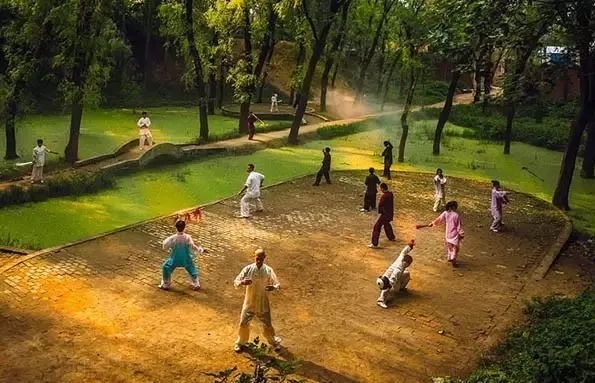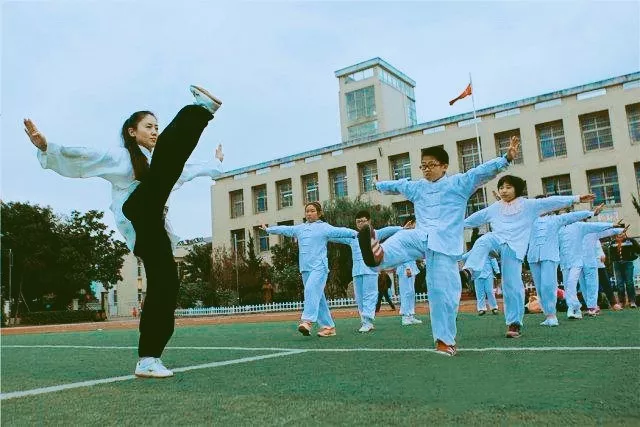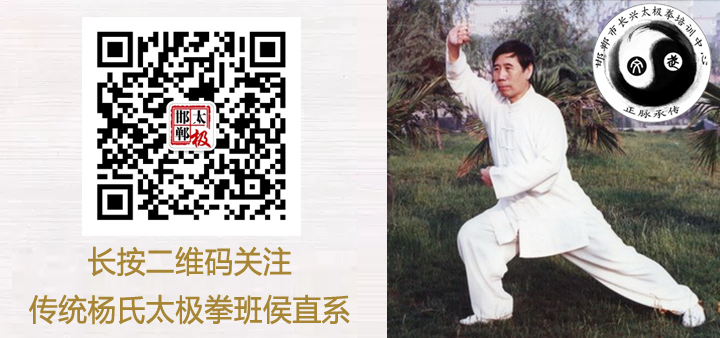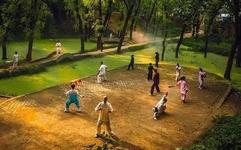
Main Methods of Tai Chi
Include: Peng (Ward Off), Lu (Roll Back), Ji (Press), An (Push), Cai (Pluck), Ba (Split), Zhou (Elbow), Kao (Shoulder), Fen (Divide), Yun (Cloud), Tui (Push), Lou (Pull), etc. These techniques, along with Zai (Plum Blossom), Ban (Move), Lan (Intercept), Pie (Flick), Da (Hit) and leg techniques like Deng (Kick), Fen (Split), Pai (Slap), Bai Lian (White Lotus), as well as stepping methods like Jin Bu (Advance), Tui Bu (Retreat), and Ce Xing Bu (Side Step), form the fundamental skills of Tai Chi training. Practicing these basic skills allows for a comprehensive development of Tai Chi techniques, enhancing the standardization of movements and laying a solid foundation for further learning of Tai Chi forms.
Basic Techniques
(1) Hand Shapes
1. Quan (Fist): Fingers curled naturally, held loosely, not too tight, with natural and relaxed force.
2. Zhang (Palm): Fingers naturally extended slightly apart, the tiger’s mouth rounded, palm concave.
3. Gou (Hook): Fingers naturally pinched together at the first joint, wrist bent.
(2) Hand Techniques
1. Peng: Bend the arm into an arc, with the elbow hanging down in front of the body, palm facing inward, above shoulder level, force reaching the outer side of the forearm.
2. Lu: Both arms slightly bent, palms facing each other diagonally, drawing an arc from front to back to the abdomen.
3. Ji: One arm bent in front of the chest, the other hand close to the wrist of the bent arm, palm facing forward, both arms pushed forward simultaneously, maintaining a rounded shape, not exceeding shoulder height, force reaching the forearms.
4. An: Both arms extend from a bent position, pushing forward in an arc from back to front, sinking the wrist and relaxing the fingers, palms facing forward, not exceeding shoulder height, force reaching both palms.
5. Da Quan (Punch): The fist rotates inward from the waist and strikes forward, force reaching the fist surface. The fist with the palm facing up is a standing fist, while the palm facing down is a flat fist.
6. Zai Quan (Plum Blossom Punch): The fist strikes downwards from above, with the fist surface angled down, force reaching the fist surface.
7. Guan Quan (Piercing Punch): The fist strikes horizontally from a side-downward direction to an upward arc, with the arm slightly bent, fist angled down, force reaching the fist surface.
8. Pie Quan (Flick Punch): The fist strikes forward with the arm flipping from above, fist surface angled upward, level with the head, force reaching the back of the fist.

9. Fen Zhang (Separate Palm): Both hands separate from a hugging position to the front or back or side, with both arms slightly bent.
10. Lou Shou (Pulling Hand): One palm sweeps horizontally from the abdomen outward, palm facing down.
11. Tui Zhang (Pushing Palm): The palm pushes forward from the shoulder or chest, with the elbow relaxed and slightly bent, palm facing forward, fingertips pointing up.
12. Chuan Zhang (Passing Palm): The palm extends along the other arm or the inner thigh, fingertips pointing forward.
13. Yun Shou (Cloud Hands): Both palms in front of the body, alternately crossing from inside to outside and upward in a circular motion, not lower than the groin and not higher than the head.
14. Jia Zhang (Frame Palm): Bend the arm upward, placing the palm above the forehead, palm facing outward at an angle.
15. Cheng Zhang (Supporting Palm): Both palms support upward or outward, applying symmetrical force.
16. Ya Zhang (Pressing Palm): Thumb inward, palm facing down, pressing horizontally.
17. Tuo Zhang (Lifting Palm): Palm facing upward, lifting from below to above.
18. Tiao Zhang (Raising Palm): Transitioning from fingertips pointing forward to fingertips pointing upward, side palm lifting from below to above, level with the eyebrows.
(3) Step Types
1. Gong Bu (Bow Step): Feet separated front and back, front leg bent at the knee, thigh angled towards the ground, toes pointing forward, knee aligned with toes, back leg naturally straightened, toes angled forward, with the whole foot on the ground.
2. Xu Bu (Empty Step): Back leg bent in a half-squat, toes angled forward, whole foot on the ground, front leg slightly bent, using the front foot or heel to touch the ground.
3. Pu Bu (Squatting Step): One leg fully squats, whole foot on the ground, toes pointing outward; the other leg extends naturally to the side, toes pointing inward, whole foot on the ground.
4. Ban Ma Bu (Half Horse Step): Front foot pointing slightly inward, back foot pointing outward, feet about three foot lengths apart, whole foot on the ground. Both legs bent, thighs above horizontal, center of gravity shifted to the back leg.
5. Xie Bu (Rest Step): Both legs crossed in a squat, stacked front and back, front foot flat on the ground, toes pointing outward, back foot heel lifted.
6. Ding Bu (Stable Step): Both legs bent and together, one foot flat on the ground for support, the other foot touching the ground with the front foot on the inside of the supporting leg.
(4) Step Methods
1. Shang Bu (Advance Step): The back foot steps forward through the inside of the front foot (supporting foot).
2. Tui Bu (Retreat Step): The front foot steps back through the inside of the back foot (supporting foot).
3. Gen Bu (Following Step): The back foot steps forward half a step, not exceeding the front foot.
4. Ce Xing Bu (Side Step): Both feet move sideways in parallel continuously.
5. Bai Bu (Swing Step): Toes point outward while stepping forward, forming an external eight shape with the back foot.
6. Kou Bu (Hook Step): Toes point inward while stepping forward, forming an internal eight shape with the back foot.
7. Nian Jiao (Rolling Step): Rotating around the heel or ball of the foot.
(5) Leg Techniques
1. Fen Jiao (Splitting Leg): The supporting leg slightly bent for stability, the other leg bent at the knee and lifted, then the lower leg swings upward, leg straightened, foot flat, higher than the waist.
2. Deng Jiao (Kicking Leg): The supporting foot slightly bent for stability. The other leg bent at the knee and lifted, lower leg swings upward, toes pointed back, using the heel to kick out, foot higher than the waist.
(6) Body Shape
1. Head: Slightly lifted with an upward intention, not tilted or swaying, expression dignified, eyes looking straight ahead, mouth lightly closed, tongue against the upper palate.
2. Neck: Naturally upright, flexible in movement, not stiff.
3. Shoulders: Level, relaxed, not raised, hunched, or leaning back.
4. Elbows: Naturally bent and hanging down, preventing raised elbows or straight arms.
5. Wrists: Sinking “collapsed wrist,” with strength concentrated, not soft.
6. Chest: Relaxed and slightly contained, not protruding outward or intentionally drawn inward.
7. Back: Extended and straightened, not hunched.
8. Waist: Relaxed and sinking down, flexible in rotation, not arched forward or leaning back.
9. Spine: Upright and straight, maintaining a natural and correct body shape.
10. Hips: Slightly tucked inward, not protruding outward.
11. Hips: Relaxed and contained, strength concentrated in the lower limbs, not twisted or protruding forward.
12. Legs: Stable and solid, bent appropriately, rotating lightly, moving smoothly, knees relaxed and natural, distinguishing between weight and lightness in the feet.
(7) Body Method
The body maintains a centered and comfortable position, rotating flexibly, neither leaning nor biased, naturally and steadily; movements revolve around the waist, driving the limbs, with upper and lower parts following each other, distinguishing between weight and lightness, avoiding stiffness or floating softness, sudden rises or falls; postures should be expansive and graceful, complete and continuous.
(8) Eye Method
Focus on concentration, guided by intention. In fixed positions, the eyes look straight ahead or focus on both hands; during transitions, the eyes coordinate with hand techniques, step methods, and body methods. The eyes follow the movements, with a natural expression.

If there are any copyright issues, please contact the original author through the backend.The articles posted are for learning reference only. Please practice under the guidance of a professional teacher.

Official Website: http://www.yunshuiwang.com



